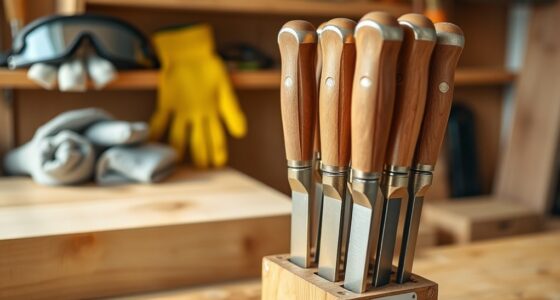To care for hand planes, keep the blades sharp with a honing guide or sharpening stone for smooth cuts and to prevent tear-out. Regularly check for rust and remove it promptly using steel wool or rust removers, then apply a light coat of oil to safeguard metal parts. Store your planes in a dry environment with silica gel packets or dehumidifiers. Proper maintenance ensures your tools stay effective and last longer—continue to explore how to keep your hand planes in top condition.
Key Takeaways
- Regularly sharpen blades to maintain a clean, effective cutting edge and ensure smooth planing.
- Clean and dry hand planes after use, then apply a light oil coating to prevent rust formation.
- Inspect tools frequently for rust or damage, using rust remover or steel wool as needed.
- Store hand planes in a dry, climate-controlled environment with silica gel or dehumidifiers to reduce moisture.
- Perform routine maintenance, including blade sharpening and rust prevention, to extend tool lifespan and ensure optimal performance.

Have you ever wondered how skilled woodworkers achieve smooth, precise surfaces? The secret often lies in the way they maintain their hand planes. Proper care begins with understanding the importance of blade sharpening. A sharp blade makes all the difference when planing wood, ensuring clean, effortless cuts and reducing the risk of tear-out. Regularly sharpening your blade keeps it in peak condition, which not only improves the quality of your work but also extends the life of your hand plane. When sharpening, focus on removing any nicks or dullness, maintaining the correct bevel angle, and honing it to a fine edge. Using a sharpening stone or honing guide can help you achieve consistent results, making your planing smoother and more precise.
In addition to keeping your blade sharp, rust prevention plays an essential role in maintaining your hand plane. Rust can develop quickly if your tools are left exposed to moisture or humidity, impairing the blade’s cutting ability and corroding other metal parts. To prevent rust, make sure to clean and dry your hand plane thoroughly after each use. Applying a light coat of oil, such as linseed or mineral oil, creates a protective barrier against moisture. Store your hand planes in a dry, climate-controlled environment, and consider using silica gel packets or a dehumidifier if you’re in a particularly humid area. Regularly inspecting your tools for signs of rust allows you to catch and treat corrosion early, using fine steel wool or rust remover products. Proper rust prevention not only preserves the tool’s functionality but also saves you money and effort in the long run. Additionally, understanding sound vibrations and their effects can help you choose the right storage environment to minimize damage from environmental factors.
Maintaining your hand plane isn’t just about initial setup; it’s an ongoing process that involves routine checks and careful handling. Keep the blade sharp through regular sharpening sessions, and never neglect the importance of rust prevention. A well-maintained hand plane will perform smoothly, producing clean, accurate surfaces that elevate the quality of your woodworking projects. Remember, the effort you put into caring for your tools pays off in the precision of your work and the longevity of your equipment. When you develop good habits around blade sharpening and rust prevention, you’ll find that your hand planes become reliable companions in your woodworking journey, helping you achieve professional-looking results with less effort and frustration.
Frequently Asked Questions
How Do I Identify the Right Hand Plane for Specific Tasks?
You identify the right hand plane for specific tasks by considering the blade sharpening needs and ergonomic grips. For fine, precise work, choose a smoother with a sharp blade and comfortable grip. For rougher tasks, a jack plane with a sturdy blade and ergonomic handle helps reduce fatigue. Think about the material you’re working on and the level of detail, matching the plane’s features to your project requirements.
What Are Common Signs My Hand Plane Needs Replacement?
Think of your hand plane as a trusted friend on your woodworking journey. When the blade dulls, it’s like your friend losing their sharp wit—work becomes slow and frustrating. Rust formation signals neglect, like unkempt clothes, weakening the tool’s strength. If your plane struggles to shave cleanly or feels sticky, it’s time for replacement. Trust your instincts; these signs show it’s ready to be retired and replaced for better results.
How Often Should I Lubricate My Hand Plane?
You should lubricate your hand plane regularly, ideally after every few uses, to keep it functioning smoothly. Follow maintenance tips by applying a light coat of lubricant to the moving parts and blade to prevent rust and ensure easy adjustments. The lubrication frequency depends on how often you use it; if you notice rust or stiffness, give it a quick lubrication session. Regular maintenance keeps your tool in top shape.
Can I Use My Hand Plane on Treated or Hardwoods?
Yes, you can use your hand plane on treated or hardwoods, but you need to pay attention to wood grain and blade sharpness. Hardwoods and treated woods can be tougher on blades, so make certain your blade is sharp for smooth cuts. Adjust your plane to follow the grain carefully to avoid tear-out. Regularly check and sharpen your blade to maintain peak performance, especially with tougher woods.
What Safety Precautions Should I Follow When Using a Hand Plane?
When using a hand plane, you should always wear personal protective equipment like safety glasses to shield your eyes from flying wood chips. Keep your workspace safe by ensuring it’s clean and free of obstructions, and maintain a firm grip on the tool. Always cut away from your body, and stay alert to avoid slips or accidents. Following these safety precautions helps prevent injuries and keeps your work efficient.
Conclusion
Taking care of your hand plane guarantees smooth, precise results every time. Regular maintenance, like cleaning and sharpening, extends its lifespan and improves performance. Did you know that properly maintained hand planes can last for decades or even generations? So, invest a little time now, and you’ll enjoy flawless woodworking for years to come. With the right care, your hand plane becomes not just a tool, but a trusted partner in your craft.









